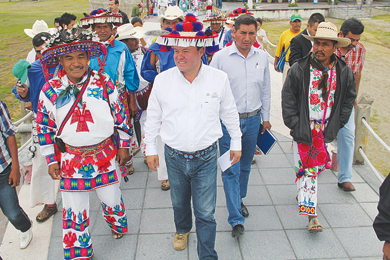Human Rights skipper takes helm on Chapala area issues
- Details
- Published on Friday, 02 August 2013 11:43
- Written by Dale Hoyt Palfrey
 Embarking on a marathon working tour in the Lake Chapala region last week, Jalisco Human Rights Commission president Felipe de Jesus Alvarez Cibrian addressed local issues revolving around indigenous cultures, clean water and public security.
Embarking on a marathon working tour in the Lake Chapala region last week, Jalisco Human Rights Commission president Felipe de Jesus Alvarez Cibrian addressed local issues revolving around indigenous cultures, clean water and public security.
The ombudsman began the July 23 visit with an event held at the Chapala Malecon, hooking up with the huge entourage of public officials and Wixaritari (Huichol Indians) who accompanied him at the three different ports of call listed on a loaded agenda.
 Chapala Mayor Joaquin Huerta, Poncitlan Mayor Victor Carrillo and Alberto Maldonado Chavarin, National Commission for the Development of Indigenous People (CDI) delegate in Jalisco and Colima were among the top dignitaries present for the occasion.
Chapala Mayor Joaquin Huerta, Poncitlan Mayor Victor Carrillo and Alberto Maldonado Chavarin, National Commission for the Development of Indigenous People (CDI) delegate in Jalisco and Colima were among the top dignitaries present for the occasion.
While Alvarez applauded the Chapala government’s progress treating waste water that empties into the lake, a key purpose of his trip was to refocus attention on the 2009 CEDHJ recommendation issued to federal, state and municipal authorities on the urgency of implementing measures to reduce severe pollution in the Santiago River.
Huerta reported that Chapala’s main treatment plant rates as statewide model of efficacy and the smaller facilities servicing Ajijic in San Antonio, Santa Cruz and San Nicolas are operating adequately. He acknowledged that a new plant for the twin towns of Atequiza and Antotonilquillo, situated in the industrial corridor running along the banks of the Santiago, remains still in the planning stages.
Prior to signing a mutual agreement to cooperate in divulging and promoting respect for human rights, both men reaffirmed their commitment to protect and conserve a Wixarika sacred site located on Scorpion Island.
Immediately afterwards, the bevy of government men and Indians boarded tourist launches for a follow-up event on the island during which Alvarez and Maldonado endorsed a formal CEDHJ-CDI pact to safeguard the spot known as Xapawleyeta.
 This rocky knoll where a wild fig tree grows symbolizes the landing place of the mythological forefather who was the sole survivor of a great deluge. Wixarika pilgrims periodically visit the Island to perform traditional rituals to conjure the forces of Rain Mother Tatei Rapahuiyeme. Once they depart, visiting tourists commonly defile the tiny shrine, pillaging the offerings left behind.
This rocky knoll where a wild fig tree grows symbolizes the landing place of the mythological forefather who was the sole survivor of a great deluge. Wixarika pilgrims periodically visit the Island to perform traditional rituals to conjure the forces of Rain Mother Tatei Rapahuiyeme. Once they depart, visiting tourists commonly defile the tiny shrine, pillaging the offerings left behind.
With a final destination in Mezcala de la Asuncion, the parties then cast off on the last leg of the day’s journey. Alvarez was pursuing a mission to deal with grievances of Mezcala’s fiercely independent indigenous population, particularly in relation to police matters and the contamination of drinking water detected in the village of San Pedro Itzican. However, the signing of the cooperative agreement between CEDHJ and the municipality of Poncitlan was delayed for close to an hour by a minor nautical mishap. The boat carrying the mayors and an official charged with carrying all the paperwork ran short of fuel en route, forcing the pilot to shift course towards Mezcala Island to resupply his vessel.


























 Proudly a member of Network of Websites - a monitored compilation of quality websites adhering to strict standards of integrity, security, modern technology, and benefits to the community.
Proudly a member of Network of Websites - a monitored compilation of quality websites adhering to strict standards of integrity, security, modern technology, and benefits to the community.